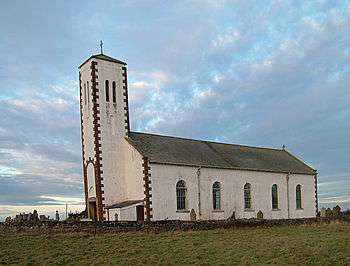Esther Nelson
Esther Nelson (1810–1843) was a Manx poet best remembered for her book, Island Minstrelsy.
She was born in 1810[1] and baptised in Jurby on June 6.[2] She was the daughter of John Nelson, a vicar in three Manx parish churches: Jurby (1803–1818),[3] Santon (1818–1830)[4] and Bride (1830–1847).[5] In 1838 she lived in Douglas[6] but had returned to the family home at the rectory at Bride by the following year, when she wrote the dedication of her book of poems, Island Minstrelsy at the age of 29: 'To her island home, the authoress affectionately dedicates the first and simple effusions of an island heart.'[7] In 1841 Nelson took a trip to Paris, apparently for health reasons,[6] but she returned to the Isle of Man where she died of tuberculosis on Tuesday 21 March 1843, at the age of 33, in her family home at the rectory at Bride.[8]
Nelson was a well-respected poet during her lifetime, often writing under the pen names "The Island Minstrel" or "Hadassah", the latter of which was given to her by G. H. Wood,[1] a gentleman poet notable for having helped guard Napoleon on Saint Helena.[9] Nelson’s work continued to be highly regarded after her death, most notably by the Manx national poet, T. E. Brown, who wrote that:
We should not forget that true woman of genius. Hester Nelson. Often I think of her, and her early doom; and Bride seems to me a shrine of splendid promise and aspirations unfulfilled save in God... My father thought very highly of her poems. Some he thought worthy of Milton. And that was all breathed in and bred from your Bride hills, and the long stretches of the Ayre.[10]

The poems of Island Minstrelsey have been described as ranging "from long narrative poems of revenge, murder and heart-break, to short contemplations of mortality, the passage of time and the fragility of happiness. They poems circle around the central idea of the inevitability of the loss of happiness and innocence in the onslaught of 'that grim spoiler, Time'."[11] This side to her work shows in the book's recurring concern with death, as is demonstrated with titles such as 'The Suicide', 'My Brother's Grave', 'The Dying Girl' and 'To the Dead'. Her most well-renowned poem is 'The Carrasdhoo Men', which told the story of a legendary group of Manx bandits.[12] Her poetry also displays a great Manx patriotism, often heightened through her selection of historical themes. The following example comes from 'Song of the Absent', which featured in William Cubbon's 1913 book, A Book of Manx Poetry:[9]
Isle of my heart,
Mona! the lone! the wild! the unforgot!
My home! thou art
The star, the idol of a wayward lot --
Earth cannot bring
One dearer vision to me than thy face,
Time cannot bring
Forgetfulness! affection mocks at space.[13]
References
- 'Nineteenth-century Literature in English relating to the Isle of Man' by Ulla Corkhill, in "A New History of the Isle of Man: The Modern Period, 1830–1999, Vol. V“ ed. John Belchem, Liverpool, Liverpool University Press, 2000, pp. 323–331 (extract available on Google Books)
- Footnote by Francis Coakley to 'Esther Nelson (B. circa 1800, d. circa 1845)' in Manx Worthies by A. W. Moore, Douglas, S. K. Broadbent and Company, 1901 (accessed April 2013))
- ‘Jurby’ in An Account of the Diocese of Sodor and Man by William Harrison, Douglas, The Manx Society, 1879
- ‘Santon’ in An Account of the Diocese of Sodor and Man by William Harrison, Douglas, The Manx Society, 1879
- ‘Bride’ in An Account of the Diocese of Sodor and Man by William Harrison, Douglas, The Manx Society, 1879
- 'Esther Nelson' on www.manxliterature.com
- Island Minstrelsy by Esther Nelson, G. B. Whittaker, London, 1839
- Obituaries in Manx Sun, 25 March 1843. Available from the Manx National Heritage iMuseum
- A Book of Manx Poetry by William Cubbon, Douglas: Manx Language Society, 1913
- "Letters of T.E. Brown." Vol. I., pp.110–11, quoted in ‘Esther Nelson (B. circa 1800, d. circa 1845)’ in Manx Worthies by A. W. Moore, Douglas, S. K. Broadbent and Company, 1901
- Description for Island Minstrelsey on www.manxliterature.com
- 'The Carrasdoo Men' by Esther Nelson, in Mona Miscellany edited by William Harrison, Douglas, The Manx Society, 1869
- ‘Song of the Absent’ by Esther Nelson, in A Book of Manx Poetry by William Cubbon, Douglas: Manx Language Society, 1913
External links
- Island Minstrelsey available from www.manxliterature.com